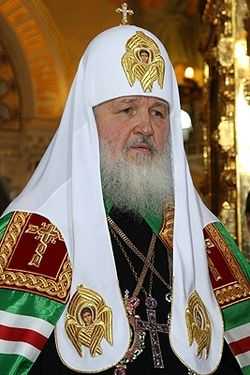Patriarch of Moscow and all Rus'
| Patriarch of Moscow and all Russia of Russian Orthodox Church
Святейший Патриарх Московский и всея Руси | |
|---|---|
 Kirill I since 1 February 2009 | |
| Style | His Holiness |
| Residence | Church of the Twelve Apostles, Moscow Kremlin |
| Nominator | Holy Synod of the Russian Orthodox Church |
| Term length | life |
| Inaugural holder | St. Job |
| Formation | 1589 |
The Patriarch of Moscow and all Rus' (Russian: Святейший Патриарх Московский и всея Руси), also known as the Patriarch of Moscow and all Russia, is the official title of the primate of the Russian Orthodox Church. It is often preceded by the honorific "His Holiness". While the Patriarch as the diocesan bishop of the Moscow diocese, has direct canonical authority over Moscow only, he, in accordance with the charter of the Russian Orthodox Church,[1] has a number of church-wide administrative powers within the ROC. The Patriarchate was established in Moscow in 1589: the first was the patriarch Job. Abolished in 1721, restored on October 28 (November 10), 1917, decision of the All-Russian Local Council. Kirill I of Moscow became Patriarch in 2009.
Etymology
In different years used different variations of the title "Patriarch of Moscow and All Russia", "Patriarch of Moscow and All Russia", "Patriarch of Moscow and all the great and small, and White Russia" and others. The modern form, "Patriarch of Moscow and All the Rus', was used in ancient times.[2]
The modern version of the title is Patriarch of Moscow and All the Rus',[3] and has been in the election as patriarch of Metropolitan Sergius (Stragorodsky) in 1943 selected by Sergius and approved by the Chairman of the Council of People's Commissars of Stalin.
History
Church reform of Tsar Peter I
Upon the death of Patriarch Adrian in 1700, Peter I did not permit election of a new patriarch; after 20 years he established a Theological College, soon renamed the Holy Synod, which, as a public body, acted as the general church administration from 1721 to January 1918 - the emperor (to March 2, 1917) as "extreme Judge this Board." In the subsequent period, the Synod of Church authorities and public administration in Russia and considered as institutions of public administration.
Restoration
The Patriarch of the Russian Orthodox Church was restored by decision of the All-Russian Church Council on October 28 (November 11), 1917, the first patriarch in was elected St. Tikhon (Bellavin), Metropolitan of Moscow.
Selection
According to the Charter of the Russian Orthodox Church adopted in 2000, patriarch is a life, the right to trial of deposed patriarch and his, as well as the question of his retirement, belongs to the Council of Bishops.
Between terms, Holy Synod of the Russian Orthodox Church elects the chair from among its permanent members of the locum tenens of the Patriarchal throne. "Not later than six months after the release of locum tenens of the patriarchal throne, and the Holy Synod of the local council ... shall convene to elect a new Patriarch of Moscow and All the Rus'."
The candidate for the patriarchs must be a bishop of the Russian Orthodox Church, not younger than 40 years old, have a "higher theological education, the expertise of the diocesan administration".
The procedure for the election of the patriarch of the charter was not detailed, "place-holder establishes the procedure for electing the Holy Synod". In 2011, the Presidium of the Inter-Council Presence reviewed the draft document "The procedure and criteria for the election of the Patriarch of Moscow and All Russia" and decided to send it to the diocese for comment and publish to the discussion. In the 20th century, Metropolitan Tikhon as patriarch was elected by lot from the three pre-approved for the Local Council candidates; between rigid state control over the affairs of the Russian Orthodox Church Sergius, Alexy I and Pimen were elected uncontested open vote on the approval of the government. Alexy II was elected to the Local Council in 1990 by secret ballot in the first round, which was attended by three candidates approved by the Council of Bishops earlier (and local council had the right to add to the list of new candidates), and the second - the two candidates with the most votes in the first round.
Patriarch enters the dignity during a special ceremony enthronement, which is held a few days after the election.
See also
- List of Patriarchs of Moscow
References
- ↑ Устав Русской Православной Церкви (принят на Архиерейском Соборе 2000 г.; Определениями Архиерейских Соборов 2008 и 2011 гг. в текст Устава был внесен ряд поправок) // IV. Патриарх Московский и всея Руси.
- ↑ Владислав Цыпин. История Русской Церкви 1917-1997. Гл. VII.
- ↑ Гл. IV, of the Charter of the Russian Orthodox Church